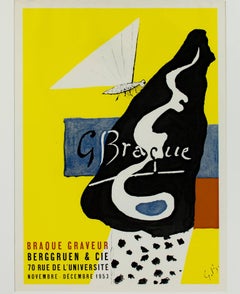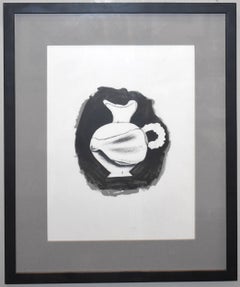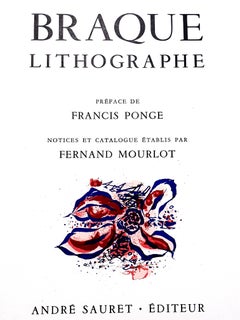Georges Braque Prints and Multiples
Georges Braque was born in Argenteuil, France, in 1882. Braque lived much of his childhood and young adult life in Le Havre. He attended night classes at the art school from 1897–99 and then moved to Paris, where he obtained his license as a master decorator. From 1905–06, after studying at École des Beaux-Arts in Paris and having been influenced by the works of Henri Matisse, he began to paint in the way of Fauvism by using bright colors and taking advantage of the freedom of the composition. Paysage à L'Estaque (1906) was one of the prominent works of art made at this time.
The year 1907 was a significant time in Braque's development, wherein he visited the retrospective on Paul Cézanne and he came into contact with Picasso, who was very engrossed in the realization of Les Demoiselles d'Avignon at the time. At this point, Braque began nurturing a considerable interest in primitive art. After the First World War, Braque worked autonomously and developed a more personal style, which was characterized by vivid colors and textured surfaces. Braque painted still life, interior views, and ocean scenes. The Ateliers (1948–55) and Birds (1955–63) series were painted during this period. In 1948, he obtained his first award for painting at the XXIV Biennial in Venice.
1950s Synthetic Cubist Georges Braque Prints and Multiples
Lithograph
1950s Modern Georges Braque Prints and Multiples
Lithograph
1970s Georges Braque Prints and Multiples
Lithograph
1960s Abstract Georges Braque Prints and Multiples
Lithograph
1960s Modern Georges Braque Prints and Multiples
Lithograph
Mid-20th Century Abstract Georges Braque Prints and Multiples
Lithograph
1960s Modern Georges Braque Prints and Multiples
Lithograph
1960s Modern Georges Braque Prints and Multiples
Lithograph
1960s Abstract Georges Braque Prints and Multiples
Lithograph
1960s Modern Georges Braque Prints and Multiples
Aquatint
1950s Modern Georges Braque Prints and Multiples
Aquatint
1950s Modern Georges Braque Prints and Multiples
Aquatint
1950s Modern Georges Braque Prints and Multiples
Lithograph
Georges Braque prints and multiples for sale on 1stDibs.
Artists Similar to Georges Braque
- 1stDibs ExpertApril 5, 2022Georges Braque is known for being one of the leading artists in both the Fauve and Cubist art movements of the early 20th century. The French artist produced paintings, collages, prints and sculptures. On 1stDibs, find a variety of Georges Braque art.




